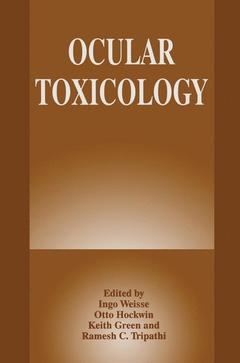Ocular Toxicology, Softcover reprint of the original 1st ed. 1995
Langue : Anglais
Coordonnateurs : Green Keith, Hockwin O., Tripathi Ramesh C., Weisse I.

On behalf of the editorial board and the organizing committee of the 4th congress of the International Society of Ocular Toxicology (I SOT), held in AnnecyNeyrier du Lac, France, October 9 -13, 1994, we are pleased to present to the ocular toxicology community this indexed volume of our congress proceedings. The 4th congress was designed primarily to facilitate and update the knowledge in ocular electrophysiology and ocular pharmacokinetics, in both the clinical and preclinical aspects. The outcome of this 4th congress, established in this volume, is a useful contribution to the meth odology in both fields and will hopefully assist in the evaluation and interpretation of ocular findings recorded in animal studies on drugs and other chemicals, in order to protect human health. Undoubtedly, work on the mechanisms of ocular toxicology in the process of pharmaceutical development must continue and these proceedings, embodying the presented papers, will add to the data base. The editors, the congress organizing committee and the members of the International Society of Ocular Toxicology thank the speakers who gave their time, knowledge, and expertise to assist us in this project. The following manuscripts contain the main substance of each of the platform presentations and, in some cases, much more. Moreover, our thanks go to all the participants coming from a range of background- regulatory, academic and industrial -for their attention and excellent contributions during the discussion.
Welcome and Opening of the Congress.- A. Ocular Electrophysiology.- The ERG, EOG, and VEP in rats.- Retinal toxicology study using electrophysiological methods in rabbits.- ERG measurements in the dog, cat and monkey for toxicology specially type of electrode and anesthesia for ERG recordings.- Electroretinography in the non-human primate as a standardized method in toxicology.- Effects of clindamycin on neural function in the isolated perfused vertebrate retina.- Determination of the effect of ketamine, thiopental and halothane on the ocular electroretinographic examination of the beagle dog to define protocols to be used in dogs, monkeys and micropigs.- Experimental study of the retinal toxicity of iron after vitreous hemorrhage.- Retinal tolerance of intravitreal low-molecular-weight heparin, colchicine or interferon ß determined by eye-cup ERG in albino rabbits.- Normal ERG on rhesus monkeys (Macaca mulatta): Preliminary results of a technic using subcutaneous electrodes.- Effects of quinine on the electroretinogram of the beagle dog.- B. Ocular Pharmacokinetics.- Effect of different vehicles on ocular kinetics/distribution.- Drug distribution studies in single lens layers through the application of a sectioning technique.- Ocular pharmacokinetics of some proteolytic drugs in the course of topical application: Long-term observation.- New method of the reverse intraarterial drug infusion into final periorbital channels of the ophthalmic artery in urgent treatment of toxic opticneuropathy.- Evaluation of the effect of the vehicle on ocular distribution and bioavailability of Betaxolol.- Continuous flow contact lens delivery of diclofenac to rabbit cornea and aqueous humor.- One-year ocular toxicity study of ofloxacin ophthalmic solution in beagle dogs.- Topicalfluconazole: High penetration without corneal toxicity.- C. Lens/Cataract.- Relevance of cataract models in rodents as a tool to evidence a co- or syncataractogenic potential of drugs in preclinical studies.- Influence of PHAKANR on the lens toxicity of naphthalene in rat lenses, analyzed by isoelectric focusing of single lens layers.- Investigations into the cataractogenic potency of a non-tricyclic antidepressant.- Comparative investigations on the cataratogenic effect of a triazin-derivative in albino and pigmented rats: I. effects detected with a slit lamp.- Regionality of glycated calf lens crystallin subunits demonstrated by lectin staining.- Spatial distribution of adenosin nucleotides in lenses of species with different accommodative capacities.- Hyperbaric oxygen therapy induces a lenticular myopic shift even with shorter treatment protocol: A preliminary report.- Posterior subcapsular cataracts and raised intraocular pressure are caused by prolonged oral corticosteroid therapy in adutt patients with inflammatory bowel disease.- D. In Vitro Methods.- In vitro methods in ocular toxicology: Introductory remarks.- (3H)-arachidonic acid release as an alternative for the eye irritation test.- Cytotoxic effects of antifungal drugs on cultured human conjunctival cells.- Characterization of sialomucins expressed by human conjuctival goblet cells.- E. Regulatory Affairs.- Critical evaluation of the evidence for an association between ocular disease and exposure to organophosphorus compounds.- A practical testing strategy for the evaluation of the oculotoxic potential of chemicals.- F. Miscellaneous.- Aesthesiometry-azelastine eye drops reduce corneal sensitivity in rabbits, but not in dogs and humans.- Influence of chronic alcoholic intoxication on healing of corneal epithelial defects. Effectivity of treatment by protease inhibitor contrycal (aprotinin) and autologous fibronectin.- The use of cyclosporine A in veterinary ophthalmology.- Characterization of human tear glycoproteins by phast SDS electrophoresis, western blotting and lectin binding.- The corneal effects of 2-(2-nitro-4-trifluoromethyl-bencoyl)-cyclohexane 1,3 dione (NTBC) in the rat.- Exacerbation of spontaneous rat corneal opacities in a polymorphonuclear elastase inhibitor toxicity study.- The comet assay: A reliable and sensitive method for the documentation of UV-B induced DNA damage.- Spontaneous ocular findings and esthesiometry/tonometry measurement in the Göttingen minipig (conventional and microbiologically defined).- Measurement of intraocular pressure in cynomolgus monkeys using a TonopenR.- Lead-intoxication of dopaminergic cells in the retina.
Date de parution : 10-2012
Ouvrage de 378 p.
15.5x23.5 cm
Thèmes d’Ocular Toxicology :
Mots-clés :
development; drug; human health; kinetics; organophosphorus; pharmacokinetics; physiology; research; retina; toxicity; toxicology
© 2024 LAVOISIER S.A.S.



